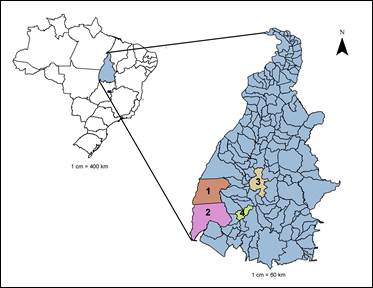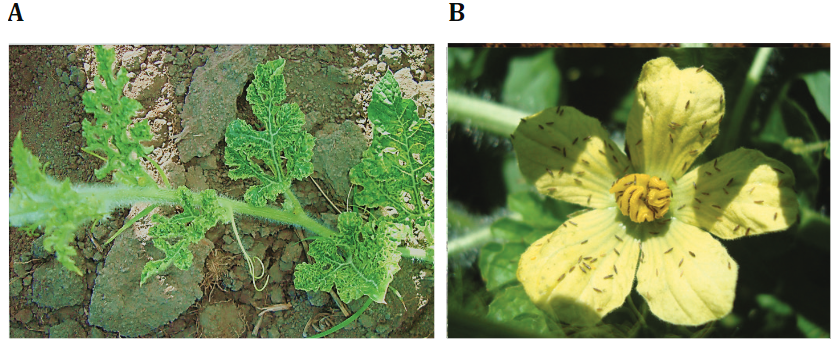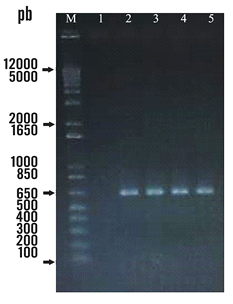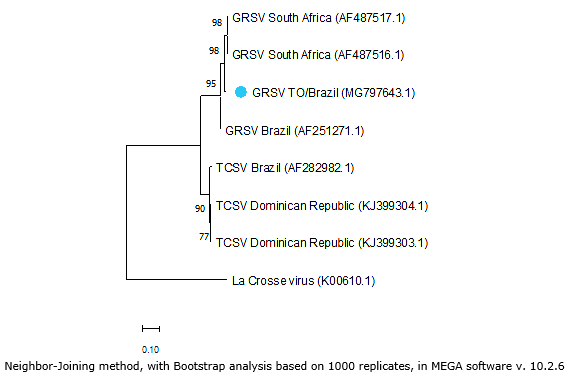INTRODUCTION
Watermelon, Citrullus lanatus (Thunb.), is one of the fruits most produced in central Brazil. Tocantins state, one of Brazil’s biggest producers of watermelon, produced 205,188 tons in 2020, reaching an economic yield of R$ 246,349 million (IBGE, 2020). Insect vectors carrying plant viruses, like thrips (Sarwar, 2020), can be found on watermelon (mainly on leaves and flowers) and are among the most important crop pests (Aguiar et al., 2019).
Diseases caused by Orthotospovirus have become a major constraint to vegetable, fruit, and legume production worldwide (Mou et al., 2021). Frankliniella schultzei thrips species are known vectors for virus of this genus (Breuil et al., 2021b; Santos et al., 2021). Orthotospovirus is transmitted from thrips in larval to pupal instars of growth, the adults being the main inoculators of plants. It is important to know that adults are proficient as vectors only if they acquire the virus at the larval stage (Rotenberg & Whitfield, 2018).
Watermelon plants exhibiting initial symptoms such as mild mottling and chlorotic spots, followed by leaf distortion, necrotic local lesion on the leaf surfaces and deformed fruits associated with the presence of Orthotospovirus (Holkar et al., 2019). Actually, in Brazil, there are reports of Orthotospovirus transmitted by thrips: Iris yellow spot virus (IYSV) in onion (De Araújo et al., 2021); Groundnut ringspot virus (GRSV) in soybeans (Fontes et al., 2019a), field pea (Fontes et al., 2017) and peanut (Michelotto et al., 2019); Tomato spotted wilt virus (TSWV) in lettuce (Fontes et al., 2019b); Tomato chlorotic spot virus (TCSV) in tomatoes (Macedo et al., 2018).
GRSV was identified in soybean crops in the presence of vector thrips like Frankliniella schultzei (Thysanoptera: Thripidae) and alternative hosts belonging to native flora around the crop ((Fontes et al., 2019a). GRSV was associated with watermelon crops and thrips on flowers, presumably F. Schultzei and F. occidentalis, in Argentina (Pozzi et al., 2021) and Brazil (Leão et al., 2014). In this context, this work aimed at the identification of GRSV thrips associated with watermelon farms of Tocantins state, in Central Brazil.
MATERIAL AND METHODS
Insect sampling
Thrips were obtained from commercial farms in 4 municipalities of Tocantins state: Gurupi (11°43ʹ45ʺ S; 49°04ʹ07ʺ W), Formoso do Araguaia (11°47ʹ48ʺ S; 49°31ʹ44ʺ W), Lagoa da Confusão (10°47ʹ37ʺ S; 49°37ʹ25ʺ W), and Porto Nacional (10°42ʹ29ʺ S; 48°25ʹ02ʺ W) (Figure 1).

Figure 1 Location of insect samples collected in municipalities of the State of Tocantins: (1) Formoso do Araguaia; (2) Lagoa da Confusão; (3) Gurupi and (4) Porto Nacional.
Specimens were collected according to Waquil et al. (1986). For this, we collected flower and apical tissues of watermelon plants infected with trips in a random zig-zag pattern, choosing two farms per municipality and ten plants per farm. In addition, the samples were placed in paper bags and transported at ambient temperature. In the Integrated Pest Management Laboratory of the Federal University of Tocantins, Gurupi campus, samples were placed at - 5°C prior to screening to handle the insects. Total samples were then pooled and stored in Eppendorfs at -80°C for RNA analyses. A total of 1,569 specimens were collected in the floral and apical tissues of watermelon `Crimsom Sweet´ plants between 2013/14 crop years. Sample collection was done twice in each region during the crop flowering period (Figure 2).

Figure 2 Thrips infestation on watermelon flowers in commercial crops being: (A) watermelon branches with thrips presence; (B) watermelon flower with a high incidence of thrips. Photos were obtained from the producing municipality of Porto Nacional-TO, Brazil.
Virus molecular identification
GRSV has been identified in association with trips species F. schultzei, F. tritici, and F. insularis (Queiroz et al., 2016). Total viral RNA to be obtained from the thrips was enriched according to the procedures of Candresse et al. (2014), where 1 g of sample was placed in an Eppendorf tube and liquid nitrogen was added to macerate. Then, three times, the sample was washed with Hank´s buffer solution and centrifuged. Finally, DNAse and RNAse were added. Total RNA extraction was performed with TRIzol™ Reagent (Invitrogen™, Massachusetts, USA), according to the manufacturer's protocol. Sample integrity was assessed by 0.8% agarose gel electrophoresis containing ethidium bromide (concentration of 0.5 µl/mL). Also, the samples were quantified on a NanoVue Plus Spectrophotometer apparatus.
Total RNA was used in two steps for cDNA preparation, and PCR was performed from the obtained cDNA. The cDNA was then used as a template with specific primers (forward: 5’-TATTCTTTCCCTTTGTTTAT-3’ and reverse: 5’-ATGTCTAAGGTCAAGCTCAC-3’) to amplify a fragment of 644 bp of the N region encoding the GRSV nucleocapsid. Reverse transcription-polymerase chain reaction (RT-PCR) was performed according to the following steps: initial 94°C/5 min, followed by 35 cycles at 95°C/30 s, 52°C/1.30 s, 72°C/4 min, and the final extension at 72°C/8 min. The amplicon obtained was sequenced using the Illumina HiSeq 2500 Kit TruSEq by Macrogen Inc. (Seoul, South Korea) at the Catholic University of Brasília (Brasilia-DF, Brazil). The sequence obtained was identified and compared with a database of NCBI using Blast.
The same sequence was used for phylogenetic analysis by the neighbor-joining method with Bootstrap analysis based on 1000 replicates in MEGA-X Version 10.2.6 software using 13 sequences deposited in GenBank. The complete sequence of segment S was deposited in the GenBank with accession MG797643.
RESULTS AND DISCUSSION
The RT-PCR confirmed the presence of GRSV in thrips samples obtained from productive watermelon crops of four municipalities in the Tocantins state by amplifying 644 pb of GRSV from the thrips samples, corresponding to the nucleocapsid protein (N) shown in the 0.8% agarose gel (Figure 3). The primers used for virus identification were designed from the sequences of the coding region of the N protein, due to this protein region retaining original characteristics among species, considered fundamental for the taxonomic classification of orthotospoviruses (Zarzynska-Nowak et al., 2018; Herath et al., 2020).

Figure 3 Identification of GRSV N protein with 644 bp by RT-PCR in thrips samples collected from watermelon crops, in 0.8% agarose gel. (M) 1 kb marker; (1) Negative control (PRSV-W); (2) Sample of Gurupi; (3) Sample of Formoso do Araguaia; (4) sample of Lagoa da Confusão; (5) Sample of Porto Nacional.
The identification of GRSV in commercial crops can be associated with thrips like F. schultzei due to their high affinity and distribution in watermelon crops. Rotenberg & Whitfield (2018) mentioned some GRSV vectors such as F. gemina, F. occidentalis, and F. schultzei. These thrips of the family Thripidae possess a piercing-sucking mouthpart that allows delivering the virus into the plant cells. Their holometabolous development may also influence the accumulation of virus in the thrips' body. The thrips samples used in the present investigation were analyzed by Queiroz et al. (2016), who identified the presence of the following thrips species F. schultzei, F. tritici, and F. insularis. Also, researchers Leão et al. (2014) demonstrated an association between GRSV and the insect vector F. schultzei, which is widely distributed in all Brazilian regions.
The phylogenetic analysis was created using the nucleocapsid (N) protein sequences deposited in GenBank, corresponding to GRSV and TCSV (with a high level of molecular relatedness) (Ciuffo et al., 2008), and also an outgroup sequence of La Crosse virus (Figure 4). This analysis showed a close relationship between GRSV from South Africa and Brazil since the gene sequence encoding the GRSV nucleocapsid protein from the Tocantins showed a high nucleotide identity (96.1% to 97.7%) to sequences from South Africa (Pietersen & Morris, 2002), Argentina (Breuil et al., 2021a; Pozzi et al., 2021), and other Brazilian regions (Boari et al., 2002; Fontes et al., 2018).

Figure 4 Phylogenetic tree obtained from the sequence alignment of the nucleocapsid protein (N) by comparing the similarity with 7 Orthotospoviruses members available in Gen Bank.
The sequence detected from the Tocantins state samples presented a high degree of identity with GRSV isolates elsewhere in Brazil (Alagoas). These results indicate that the virus GRSV present in the Tocantins state could have originated in other Brazilian regions. Although viral sequences were not investigated in the plant samples, these results demonstrate the occurrence of the GRSV virus in thrips sampled from watermelon plants, possibly indicating a transmission route to watermelon in this state. Previous reports have been made of GRSV infecting watermelon plants in the São Paulo state (Leão et al., 2014) and Bahia state (Maeda et al., 2021).
In Brazil, GRSV has been previously reported to infect thrips, but this is the first report of this occurrence in watermelon crops, specifically the thrips species F. schultzei. Moreover, this insect vector is found in other regions of Brazil (Lima et al., 2013; Leão et al., 2014), and previous work has shown that it has a high incidence in watermelon crops within the Tocantins state (Queiroz et al., 2016). Finally, F. schultzei has already been reported as a GRSV vector with a high affinity for tomato plants (Nagata et al., 2004).
Control of orthotospoviruses is difficult due to their high rate of reassortment of genome sequences and dependence on a single gene that confers resistance in culture systems. In addition, their vector can spread easily because of its size and ability to develop resistance to insecticides (Gilbertson et al., 2015). Therefore, the identification of thrips species and viruses associated with the commercial cultivation of watermelon in the state of Tocantins presents a challenge to establish an alternative for the employment of integrated management for the control of the insect, with possible reductions of direct and/or indirect damage caused in the crop.
Analyses on tomato seeds showed that Tomato brown rugose fruit virus (ToBRFV) was localized in the seed coat and eventually in the endosperm; its transmission from infected seeds to seedlings occurs by micro-lesions during germination (Davino et al., 2020). Likewise, researchers demonstrated that Tomato leaf curl New Delhi virus (ToLCNDV) is a seed-transmissible virus in zucchini plants in Italy (Kil et al., 2020). Considering the previous information, the analysis of GRSV seed transmission is necessary due to its presence in other states of Brazil.
For this effective management, it is necessary to understand the virus-vector-host relationships and the relationship of the insect vector with the environment, considering the environmental stress factors that can cause changes in its morphology, physiology, and behavior (Gutiérrez, 2020). Some effective strategies used for the control of Trialeurodes vaporariorum in tomatoes, a vector of several viruses, are biological control using larval stage individuals of Chrysoperla externa (Castro et al., 2016) and yellow sticky entomological traps with LED lights (Castresana & Puhl, 2015).
CONCLUSIONS
We identified the Groundnut ringspot virus (GRSV) associated with Frankliniella sp. (Thysanoptera: Thripidae) in commercial watermelon fields cultivated in Gurupi, Lagoa da Confusão, Formoso do Araguaia, and Porto Nacional counties, which are located in the Brazilian state of Tocantins, Brazil. This finding deserves special attention from the authorities. Furthermore, by using specific primers of 644 bp fragment of the GRSV nucleocapsid and RT-PCR, our phylogenetic analysis allowed us to establish Tee close relationship between the South African and Brazilian GRSV sequences.















